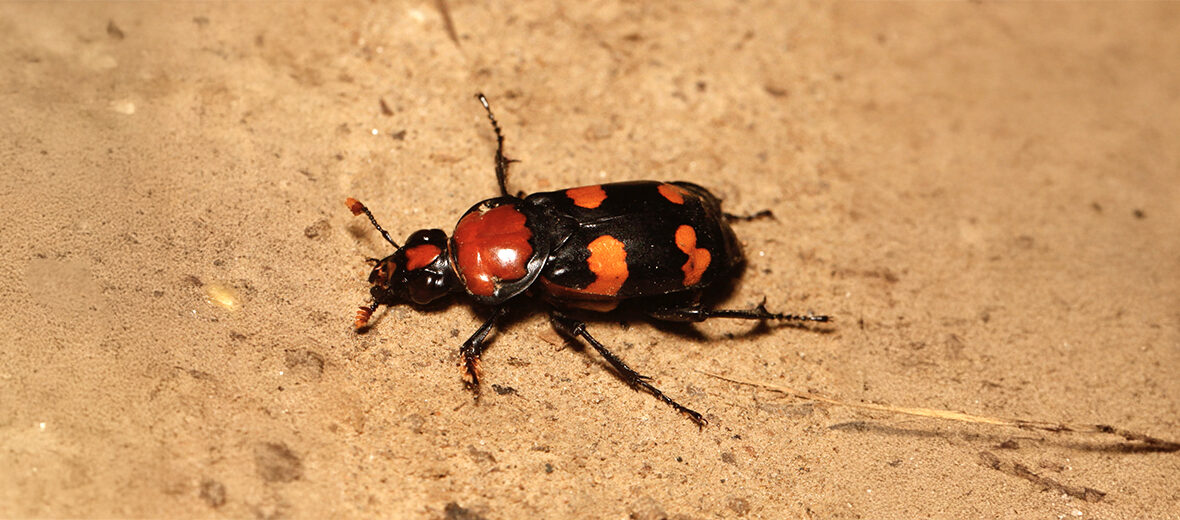
The American burying beetle, aka giant carrion beetle, is not only carnivorous, it feeds on carrion (dead animals) and needs carrion to breed. These beetles are among the few known to exhibit parental care. They are threatened by habitat loss and destruction; habitat fragmentation; the reduction of carrion; and competition for food by other scavengers, like crows, raccoons, and foxes. The IUCN lists these beetles as Critically Endangered. Their population trend is not specified at this time.
First the Stats…
Scientific name: Nicrophorus americanus
Weight: Up to .11 ounce
Length: Up to 1.8 inches
Lifespan: Up to 1 year
Now on to the Facts!
1.) These beetles presently occur in less than 10% of their historic range, which is to say the central Great Plains, specifically in Arkansas, Kansas, Nebraska, Oklahoma, South Dakota, and Texas. There are also reintroduced populations in Ohio, Massachusetts, Missouri, and Rhode Island.
2.) Records show that these beetles once dwelled in 35 states, including the District of Columbia in the United States, as well as the provinces of Ontario and Quebec in Canada.
3.) Adults can fly upwards of .62 of a mile each night, looking for carrion.
4.) They are nocturnal (active at night).
5.) In the winter, when temperatures dip below 60°F, the adults will bury themselves in soil and overwinter.
But wait, there’s more on the American burying beetle!
6.) They typically fight over carcasses, with the largest males and females winning. They only need carrion the size of a dove or a chipmunk in order to reproduce.
7.) Once a carcass has been established, the pair mates, and the female lays her eggs in a nearby tunnel.
Did you know…?
These beetles are unusual in that both the male and female participate in raising their young.
8.) Females lay upwards of 30 eggs.
9.) Within just a few days, the larvae develop and both parents feed and tend to their offspring, an unusual activity among insects, but a characteristic that is shared with the earwig.
10.) After approximately 1 week of feeding off the carcass the larvae crawl into the soil to pupate (develop).
But wait, there’s still more on the American burying beetle!
11.) Pupation takes up to 60 days to complete.
12.) Being habitat generalists, they can tolerate a wide range of habitats. However, these beetles do have a preference for grasslands and open understory oak hickory forests.
Did you know…?
They also face threats from climate change, particularly in the southwestern portion of their range. This threat comes in the form of severe weather and flooding.
13.) In Oklahoma, petitions were made in 2015 and again in 2016 to delist the species from endangered status as they “got in the way” of the oil and gas industry in the region. Sadly, the U.S. Fish and Wildlife Service, in 2020, did reclassify the American burying beetle from endangered to threatened.
14.) Even though widespread use of pesticides may have caused local populations to disappear, the disappearance of these insects from many areas took place before widespread use of DDT.
15.) Biologists have attempted to re-establish the beetle population releasing laboratory-raised beetles on Penikese Island and Nantucket island in Massachusetts.
Now a Short American Burying Beetle Video!
Be sure to share & comment below! Also, check out the Critter Science YouTube channel. Videos added regularly!

Want to suggest a critter for me to write about? Let me know here.
Some source material acquired from: Wikipedia & IUCN
Photo credit: Blocky1OOO



